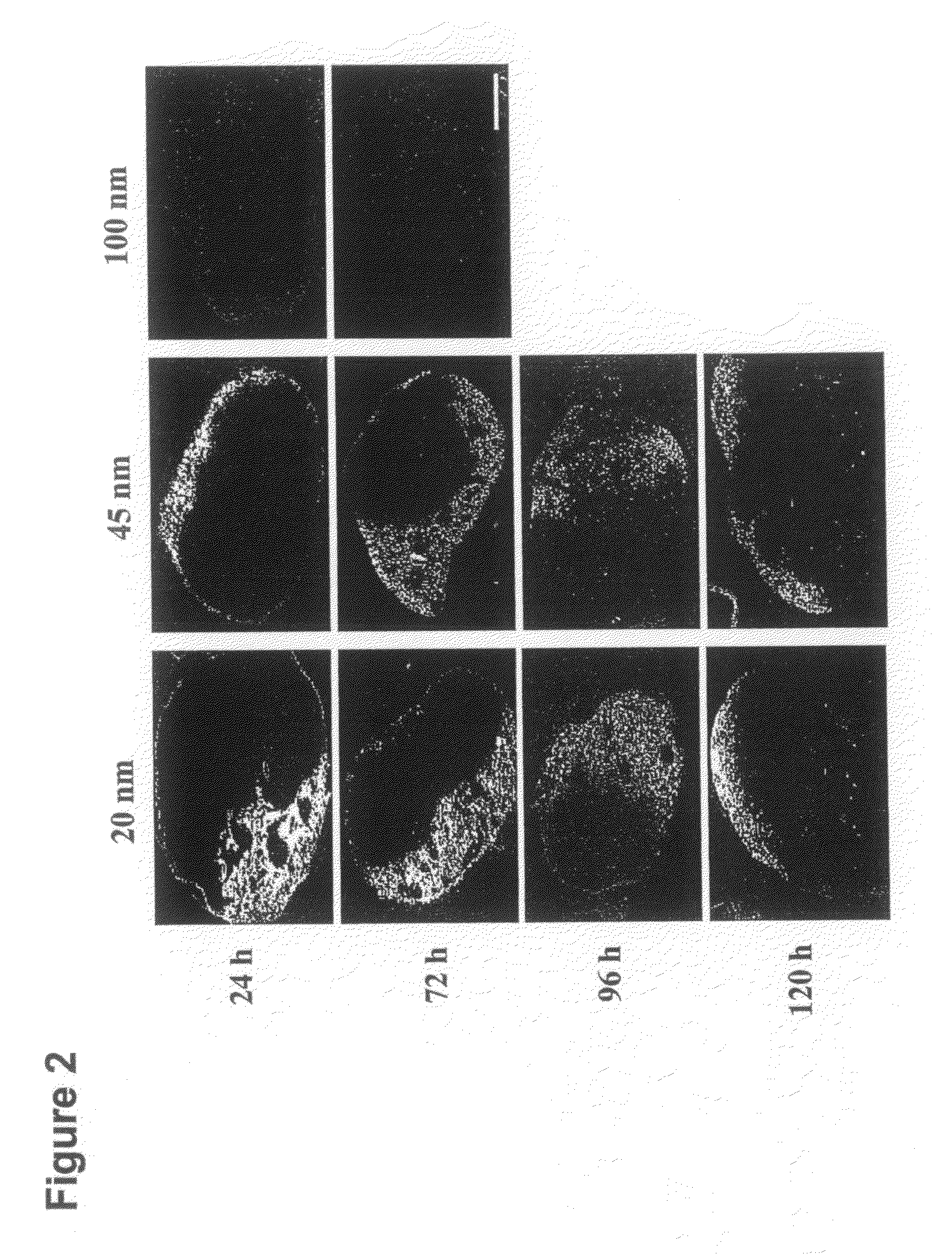Nanoparticles for immunotherapy
a technology of nanoparticles and immunotherapy, which is applied in the direction of immunological disorders, antibody medical ingredients, peptide/protein ingredients, etc., can solve the problem that too large particles cannot effectively migrate to the lymphatic system
- Summary
- Abstract
- Description
- Claims
- Application Information
AI Technical Summary
Benefits of technology
Problems solved by technology
Method used
Image
Examples
example 1
Nanoparticles
[0143]PPS nanoparticles with diameters of 20, 45, and 100 nm were synthesized by inverse emulsion polymerization as described elsewhere; in the term “emulsion polymerization” used herein, is included inverse emulsion polymerization, and in the term “emulsion”, is included inverse emulsion [39]. Briefly, an emulsion was created by adding the PEG block copolymer emulsifier, PLURONIC F-127 (Sigma-Aldrich, Buchs, Switzerland) and the monomer propylene sulfide to ultrapure milliQ water under constant stirring. The protected initiator pentaerythritol tetrathioester was synthesized as described elsewhere [39] and, in a separate flask, was deprotected by mixing it with 0.20 mL of 0.5 M sodium methylate solution under stirring for 10 min. Following deprotection, the initiator was then added to the monomer emulsion and 5 min later 60 μl of the base diaza[5.4.0]bicycycloundec-7-ene (DBU) was added to the reaction and it was allowed to stir continuously for 24 h under an inert atmo...
example 2
Synthesis of Methoxy-Terminated PLURONIC
[0145]
Pluronic F127 (Sigma), methyl iodide (Fluka), potassium hydroxide (Fluka), sodium thiosulfate penta hydrate (Riedel de Haen), anhydrous sodium sulfate (Applichem), sodium chloride (Sigma), diethylether (Fisher) and dichloromethane (Fisher) were used as received. Tetrahydrofuran stabilized with 0.025% BHT (Acros) was dried over molecular sieves before use. The reaction was carried out under argon (Messer) atmosphere. For dialysis a regenerated cellulose tube (Spectrapor) with molecular weight cut off 3400 was used. 1H NMR was measured in deuterated dimethylsulfoxide (Armar) and chemical shifts (δ) are given in ppm relative to residual solvent signal at 2.5 ppm.
[0146]To a solution of 10.0 g (0.79 mmol) PLURONIC F127 in 100 ml THF was added 2.99 g (53.3 mmol) finely ground potassium hydroxide and 988 μl (15.9 mmol) methyl iodide and the mixture stirred in the dark for 19 h. The clear solution is decanted and 3.94 g sodium thiosulfate penta ...
example 3
Animals
[0147]Unless otherwise stated, BALB / c mice, 6-9 weeks old and weighing 20-30 g, were used for this study. All protocols were approved by the Veterinary Authorities of the Canton Vaud according to Swiss law. Anesthesia was delivered by subcutaneous injection of ketamine hydrochloride at 10 mg / kg and xylazine at 1 mg / kg. Mice were euthanized by CO2 asphyxiation.
PUM
| Property | Measurement | Unit |
|---|---|---|
| Fraction | aaaaa | aaaaa |
| Particle diameter | aaaaa | aaaaa |
| Amphiphilic | aaaaa | aaaaa |
Abstract
Description
Claims
Application Information
 Login to View More
Login to View More - R&D
- Intellectual Property
- Life Sciences
- Materials
- Tech Scout
- Unparalleled Data Quality
- Higher Quality Content
- 60% Fewer Hallucinations
Browse by: Latest US Patents, China's latest patents, Technical Efficacy Thesaurus, Application Domain, Technology Topic, Popular Technical Reports.
© 2025 PatSnap. All rights reserved.Legal|Privacy policy|Modern Slavery Act Transparency Statement|Sitemap|About US| Contact US: help@patsnap.com



